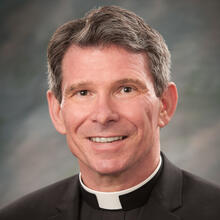Sometimes a mystery of faith is best approached through its opposite. In pondering the Assumption of the Blessed Virgin Mary, consider what it means for us to die. Of course, for all of us, on this side of the grave, death is the unexplored country. Near death experiences do not count. Pondering death itself, we can only project.
John Henry Cardinal Newman did that brilliantly, and with great beauty, in his poem, "The Dream of Gerontius." It’s about a soul—any soul—passing from life into death. It begins with the soul’s realization that death has come, interspersed with its most fervent of prayers.
JESU, MARIA – I am near to death,
And Thou art calling me; I know it now.
Not by the token of this faltering breath,
This chill at heart, this dampness on my brow, –
(Jesu, have mercy! Mary, pray for me!)
‘Tis this new feeling, never felt before,
(Be with me, Lord, in my extremity!)
That I am going, that I am no more.
‘Tis this strange innermost abandonment,
(Lover of souls! great God! I look to Thee,)
This emptying out of each constituent
And natural force, by which I come to be.
Pray for me, O my friends; a visitant
Is knocking his dire summons at my door
The like of whom, to scare me and to daunt,
Has never, never come to me before;
‘Tis death, – O loving friends, your prayers! -‘tis
he!...
As though my very being had given way,
As though I was no more a substance now,
And could fall back on nought to be my stay
(Help, loving Lord! Thou my soul Refuge,
Thou,)
And turn no whither, but must needs decay
And drop from out the universal frame
Into that shapeless, scopeless, blank abyss,
That utter nothingness, of which I came:
This is it that has come to pass in me;
Oh, horror! this it is, my dearest, this;
So pray for me, my friends, who have no strength
to pray.
Instinct fears death. Indeed, no instinct is stronger than our aversion to it, our desperate desire for life. How could we not fear “this strange innermost abandonment, this emptying out of each constituent and nature force?” But biology is only the beginning.
To be human is to live, ever to project ourselves into the future. We plan; we dream. We live each day supported by its morrow, but in death the future falls away, as “though my very being had given way, as though I was no more a substance now, and could fall back on nought to be my stay.”
That’s how we experience death, as the fearful dissolution of the world, our world.
And turn no whither, but must needs decay
And drop from out the universal frame
Into that shapeless, scopeless, blank abyss,
That utter nothingness, of which I came.
Now ponder the Assumption of the Blessed Virgin Mary. We believe that, by virtue of her deep, undivided participation in the life and death of her Son, Mary of Nazareth knew the same, deep and undivided, participation in his resurrection.
Did Mary die? If by “death” one means, did she pass from this world into the other, yes, most assuredly. Did she experience death as we do? As a frightful dissolution, as a “shapeless, scopeless, blank abyss, that utter nothingness?”
No. For her, death was door, access to a well known, beloved face. Death for us is darkness; death for her was visage. She saw the Son.
Later in the poem, Newman quite accurately depicts God’s judgment as a realization, which dawns upon the soul itself, that it is unready for the truth, the beauty, the love it sees revealed in the face of Christ. This is why the souls of the elect beg to be dipped into, what Newman calls, the “penal waters” of purgatory.
Not so with the great saints, and certainly not with Mary. For her death represented completion, fulfillment, as though every portion of her existence, every act of her life, saw itself reflected and fulfilled in the face of the Son. Her humanity, which had never known the division of sin, became illumined, translucent, incandescent.
The neophyte might ask how this is known. Through identity, not observation. We were not there to observe the sinlessness of Christ or his Mother. We know both because of who they are. God’s impeccable initiative and humanity’s single, immaculate response.
Because we have known sin, we will experienced death as darkness. But the Maid of Nazareth is still our hope and our glory. In her, one portion of humanity speaks a complete “yes” to God. One human fragment passes through death like the rays of the sun through air.
Death and its aftermath will purify our lives, but our fear should be bounded. On the other side, her peace will be our own; her Lord will be ours; and joy will be complete.
Revelation 11: 19a, 12: 1-61, 10AB 1 Corinthians 15: 20-27 Luke 1: 39-56







